Comparative Study of Adsorption Isotherms Steroidal Anti-Inflammatory Drug Dexamethasone on Carbon Nanotube and Activated Carbon
Mehdi Vadi*, Najaf Hossinie and Zahra shekari
Department of Chemistry, Gachsaran Branch, University of Gachsaran, Kohgiloyeh va Boyerahmad, Iran.
Corresponding Author E-mail: mahdi_vadi@iaufasa.ac.ir
DOI : http://dx.doi.org/10.13005/ojc/290213
In this research we have studied aimed to compare the adsorption of dexamethasone by two adsorbent; multi-wall carbon nanotube and activated carbon with the help of UV/VIS spectrophotometer Jenway 6505 model. Adsorption chart based on the wavelength of dexamethasone has been obtained and the relevant graph is plotted by considering factor of concentration. Four different concentrations necessary for adsorption of dexamethasone on multi wall carbon nanotube and activated carbon the maximum adsorption rate was determined. Study with on the results, the efficiency of that observation adsorption dexamethasone by multi wall carbon nanotube was more than activated carbon. The results can be useful in biological system and pharmacy.
KEYWORDS:Adsorption; Isotherms; Activated carbon; Multi wall Carbon nanotube
Download this article as:| Copy the following to cite this article: Vadi M, Hossinie N, Shekari Z. Comparative Study of Adsorption Isotherms Steroidal Anti-Inflammatory Drug Dexamethasone on Carbon Nanotube and Activated Carbon. Orient J Chem 2013;29(2). |
| Copy the following to cite this URL: Vadi M, Hossinie N, Shekari Z. Comparative Study of Adsorption Isotherms Steroidal Anti-Inflammatory Drug Dexamethasone on Carbon Nanotube and Activated Carbon. Orient J Chem 2013;29(2). Available from: http://www.orientjchem.org/?p=22136 |
Introduction
Carbon nanotubes (CNT) discovery by Iijima in 19911. Carbon nanotubes (CNTs) are hollow cylinders of graphite carbon atoms. These tubes are on the nano scale (10-9 m), which is so small that 10,000 of them could fit within the diameter of one human hair. Carbon nanotubes are a new form of carbon with unique electrical and mechanical properties2. They can be considered as the result of folding graphite layers into carbon cylinders. Multi walled nanotubes (MWNT) consist of multiple rolled layers (concentric tubes) of grapheme. There are two model, sheets of graphite are arranged in concentric cylinders, e.g., a (0.8) single walled nanotube (SWNT) within a larger (0.17) single-walled nanotube 3. Recent discoveries of various forms of CNTs have stimulated research on their applications in varied fields. The nature of bonding in carbon nanotubes (CNTs) is described by applied chemistry, specifically, orbital hybridization4. This chemical bonding is composed entirely of sp2 bonds, similar to those of graphite. This bonding structure, which is stronger than the sp3 bonds found in diamond, provides the molecules with their particular strength5 . CNTs are the strongest and hard materials on earth, in terms of supple strength and elastic modulus respectively. This strength results from the covalent sp² bonds formed between the individual carbon atoms6. As for thermal conduction, the CNT surpasses even that of diamond, reaching almost double the value diamond. Carbon nanotubes (CNT) possess many particular characteristics that promise to revolutionize the world of structural materials resulting in significant impact on our capability to build lighter, higher performance structures for aerospace and many other industrial applications7. Dexamethasone is a type of steroid drug known as a glucocorticosteroid. It is a man-made version of a natural hormone produced by the adrenal glands.Glucocorticosteroids have a wide range of actions on many parts of the body8 .The ways in which they cause these many different effects aren’t exactly clear. The main effects of dexamethasone and steroids like it seem to be due to their anti-inflammatory properties and their ability to alter immune system responses. For example, dexamethasone helps prevent white blood cells from traveling to areas of the body where they might add to swelling problems (such as around tumors) 9-10. It also seems to help with the treatment of certain blood cancers (such as leukemia’s) by causing some cancerous white blood cells to commit suicide .We studied adsorption of some drugs on carbon nanotubs 11-27 The reasons for some of it’s other actions ( such as increasing appetite and reducing nausea ) aren’t as clear. Designated chemically as 9- Fluoro-11,17-dihydroxy-17-(2-hydroxyacetyl)-10,13,16-trimethyl6,7,8,9,10,11,12,13,14,15,16,17-dodecahydro-3H-cyclopenta [a]phenanthren-3-one. The molecular weight is 392.461 g/mol. Its molecular formula is C22H29FO5. The structural formula is:
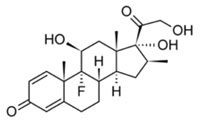
Experimental
Substances
Ethanol (purity %96) as solvent,activated carbon and multi-wall carbon nanotube with 95%pure degree, production of neutrino Company.Dexamethasonewith 99% pure degree production ofPharmaceuticalcompaniesdaro pakhsh.
Devices used
In this researcher spectrophotometer UV / VIS Jenway 6505 model England, magnetic stirrer (Heidolph, Mr3001 Model), Analytical balances (Sartorius Model), Filter paper (Albet), were used.
Adsorption experiments
In order to provide dexamethasone solution, twice distilled water was use.multi walled carbon nanotube was used as an adsorbent. First 50ppm of dexamethasone was provided using this sample, some solutions with different concentrations of 4to 12 mg/lit of pure dexamethasone were prepared specific amount of carbon nanotube (0.005gr) was added to flasks containing dexamethasone , as an adsorbent .it was stirred , using a magnetic stirrer for 10 minutes. Then liquid and solid phase were separated by means of a filter paper. The concentration ofdexamethasone was measured by using on spectrophotometer tool adsorption rate, gained for dexamethasone. All tests have been performed at the lab with the temperature of (25 ± 2°C). In a two component system consisting ofabsorber solution, a graph of the concentration of dissolved solid phase qe (mg / g) was dissolved in the solution concentration Ce (mg/L) in an equilibrium adsorption isotherm is expressed. In a liquid-solid adsorption from solution on to the surface of the separation of dissolved solids remaining dissolvedin the solution until the solution reaches the dynamic equilibrium on a solid surface. The Freundlich, Langmuir and Temkin models are employed to analysis adsorption occurred in the experiment. Adsorption isotherms to describe the adsorption capacity to facilitate the process of evaluating the feasibility of the intended application and is useful for the analysis and design of adsorption systems.
Langmuir model
The Langmuir adsorption model is the most common model used to quantify the amount of adsorbs ate on an adsorbent as a function of partial pressure or concentration at a given temperature. This equation expressed by relation.

in this equation, (mg.) is the solution was adsorbed the surface and is equilibrium constant of adsorption and b is the capacity of adsorption in saturated single layer and (Mg.) Is solution in equilibrium state?
Freundlich model
The Freundlich equation or Freundlich adsorption isotherm is an adsorption isotherm,which a curve is relating the concentration of a solute on the surface of an adsorbent, to the concentration of the solute in the liquid with which it is in contact. In 1909, Freundlich gave an empirical expression representing the isothermal variation of adsorption of a quantity of gas adsorbed by unit mass of solid adsorbent with pressure. This equation is known as Freundlich adsorption Isotherm or Freundlich adsorption equation. This model is specified with equation.
![]()
In this equation, (mg.) is amount of absorbed material in absorbent surface, K; n in arrangement are adsorption capacity and adsorption intensification.
Temkin model
The Temkin model is linearly represented as equation (3) and generally applied in the form:
Where A and B are the Temkin isotherm constant (L/g) and heat of sorption (J/mol) respectively. R is the gas constant (J/mol/k), b is the Temkin isotherm constant linked to the energy parameter, B, as shown on equation:
![]()
T is the absolute temperature in Kelvin.
Results
Table 1 shown the absorbance of dexamethasonein the absent of activated carbon and carbonnanotube in 238 nm wavelength. As seen, table1 shown the amount of absorbance isincreased when concentrations are increased. Table2 shown the increasing absorbance of dexamethasone against the concentrations in the presence ofcarbon nanotube,Table3 also shown the increasing absorbance of dexamethasone against the concentrations in the presence ofactivated carbon.calculatedparameters of these models are shown in Table 4 and The Langmuir, Freundlich and Temkin isotherms of the adsorption process of dexamethasone on AC and CNT are shown in figures 3 to 5. It was observed that the experimental data were well represented by Langmuir Freundlich and Temkin models.
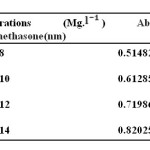 |
Table 1: Absorbance of Dexamethasone in the absent of Carbon nanotubesand Activated carbon. Click here to View table |
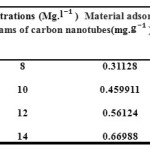 |
Table 2: The amount of Dexamethasoneon 0.005 grams of carbon nanotubes Click here to View table |
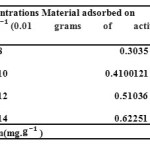 |
Table 3: The amount of Dexamethasoneon 0.005 grams ofActivated carbon. Click here to View table |
Table 4: Parameters of Langmuir, Freundlich and Temkin isotherms of theDexamethasone on Carbon nanotubes and Activated carbon
|
|
Langmuir |
|
Freundlich |
|
Temkin |
|
||||||
|
b |
q |
|
n |
|
B |
|||||||
|
Carbon nanotubes |
0.36 |
1.25 |
0.994 |
1.59 |
7.48 |
0.92 |
188 |
0.66 |
0.896 |
|||
|
Aactivated carbon |
1.5 |
3.38 |
0.996 |
10.5 |
4.55 |
0.82 |
268 |
0.36 |
0.8264 |
|||
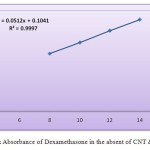 |
Figure1: Absorbance of Dexamethasone in the absent of CNT & AC Click here to View figure |
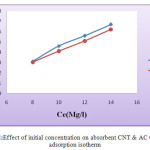 |
Figure 2: Effect of initial concentration on absorbent CNT & AC Curve adsorption isotherm Click here to View figure |
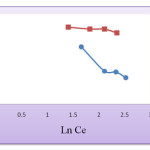 |
Figure 3: Freundlich isotherm of Dexamethasone on CNT& AC. Click here to View figure |
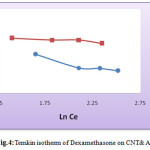 |
Figure 4: Temkin isotherm of Dexamethasone on CNT& AC. Click here to View figure |
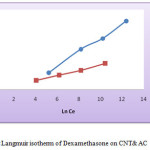 |
Figure 5: Langmuir isotherm of Dexamethasone on CNT& AC. Click here to View figure |
Study of adsorption isotherm
Calculated parameters based on exothermic equations are shown in table 4, As seen, the values of correlation coefficient (R2) for the absorbance ofdexamethasonewith the use of carbonnanotube for Langmuir, Freundlich and Temkin models are 0.994, 0.92 and 0.896 and with the use of activated carbon are 0.996, 0.82 and 0.8264, respectively. The results showed
that the absorbance of dexamethasone on both absorbent is in conformance with Langmuir and Freundlich isotherm.
Conclusion
In this study we compare the adsorption isotherms of dexamethasone by activated carbon and carbon nanotube. Base on obtained results we conclude that nanotube has moreefficiency in removal of dexamethasonerather than activated carbon.Results of isoth- ermic experiments showed that the correlation coefficient of Langmuir isothermic’s equation for carbon nanotube was more than activated carbon. The values of RL in carbon nanotube and activated carbon were less than 1, indicating that the absorbance is appropriate for both adsorbents. Therefore, in total, it is concludedthat correlation coefficient (RL) in Langmuir isotherm model for carbon nanotube were higher and it’s efficiency in the removal of dexamethasoneis better than activated carbon.
References
- Iijima, Nature 354 (1991), P.56
- PG,CollinsP.Avouris Nanotubes forelectronics. Sci. A 2000; 283: 38 – 45.
- Single-Walled Carbon Nanotubes on CleanSubstrates .Nanotechnology: A Guide to Nano- Objects.Chemical EngineeringProgress 107 (5): 28–32
- Treacy, M.M.J.; Ebbesen, T.W.; Gibson, J.M. “Exceptionally high Young’s modulusobserved for individual carbon nanotubes”.Nature 381 (6584): 678–680, (1996)
- T. Hertel, R. Martel and P. Avouris,Manipulation of Individual Carbon Nanotubesand Their Interaction withSurfaces, J. Phys.Chem. B 102:910915(1998).
- H. Dai, E.W. Wong and C. M. Lieber,ProbingElectrical Transport in Nanomaterials:Conductivity of Individual Carbon Nanotubes,Science, 272: 523-526 (1996).
- Arth GE, Fried J, Johnston DBR, Hoff, DR, Sarett HL, Silber RH, Stoerk HC,Winter CA(1958).”16-Methylated steroids.II. 16α-Methyl analogs of cortisone, a new group of anti-inflammatorysteroids.9α-Haloderivatives”. Journal of the AmericanChemical Society 80(12):3161
- chmelzeisen R, Frölich JC (1993). “Prevention of postoperative swelling and pain by dexamethasone after operativeremoval of impacted third molar teeth”. J.Clin. pharmacology.44(3): 275–71010Chrousos GP, Detera-WadleighSD, Karl M (December 1993). “Syndromesofglucocorticoid resistance”. Ann.Intern.Med. 119 (11): 1113–24.
- M.Vadi,F.Tolou.”Study of the Frondlich, Langmuir and Temkin, adsorption isotherms for some amino acids and their complexation with Lanthanum (III) on multi-walled-carbon nanotube”. Oriental Journal of Chemistry. Vol.27(2).545-551
- M.Vadi, Y.Ghasemi.”Adsorption isotherms 2-amino phenol and 4-amino phenol on carbon nanotube”. Oriental Journal of Chemistry.Vol.27(2).563-566
- M.Vadi,M.Zakeri.”Thermodynamic study of Chrysens adsorption by multi-walled on carbon nanotube”. Oriental Journal of Chemistry.Vol.27(3).945-951
- M.Vadi,E.Ghaseminejhad.”Comparative study of isotherms adsorption of Oleic acid by activated carbon and multi-wall carbon nanotube” Oriental Journal of Chemistry.Vol.27(3).973-978
- M.Vadi.”Adsorption isotherm study of vitamin B2 on carbon nanotube”.Oriental Journal of Chemistry.Vol.27(3).1037-1040
- M.Vadi,N.Moradi.”Study of adsorption isotherms of Acetamide and Propionamide on carbon nanotube” Oriental Journal of Chemistry.Vol.27 (4).1491-1495
- M.Vadi,F.Pooladian.”Examination of surface adsorption isotherms of the complex of some amino acid with Cr (III) ion by carbon nanotube”. Oriental Journal of Chemistry.Vol.27 (4).1517-1521
- M.Vadi.”Comparative study of adsorption isotherms two non- steroidal anti- inflammatory eye drops, Indomethacin and Diclofenac on carbon nanotube” Oriental Journal of Chemistry.Vol.28(1).343-348
- M.Vadi, Y.Noshadi.” Investigation of adsorption isotherms of Oxymethalone as a kind of steroid drug by multi-wall carbon nanotube “Oriental Journal of Chemistry.Vol.28(1).297-301
- M.Vadi, A.Lorestani.”Adsorption isotherms of Diethyl and Dimethyl malonate esters on single-walled carbon nanotubes “Oriental Journal of Chemistry.Vol.28(3).1195-1199
- M.Vadi,O.Bazipour , A. Malekzadeh.”Adsorption isotherms study of Ketotifen as a drug on multi- walled carbon nanotube”. Oriental Journal of Chemistry.Vol.28(3).1285-1289
- M.Vadi, O.Bazipour , A. Malekzadeh.”Evaluation of adsorption isotherms of Frenulich, Temkin and Langmuir of Loratadine drug on multi-walled carbon nanotube” Oriental Journal of Chemistry.Vol.28(3).1305-1309
- M.Vadi,A.Omidi.” Comparative study of adsorption isotherms two non- steroidal anti- inflammatory drugs Acetaminophen and Diclofenac on carbon nanotube”. Oriental Journal of Chemistry.Vol.28(3).1325-1330
- M.Vadi, A. Maleki , F. Polladiyan,”Adorption Some Alkaline Metals and Alkaline Earths Metals on Carbon Nanotube: Asian Journal of Chemistry .Vol.22(9).6906-6910
- M.Vadi , M. Abbasi ,“Adsorption Isotherms Complexation of Some Amino Acids with Co(II) Ion on Carbon Nanotube”. Asian Journal of Chemistry .Vol.23(8). 3431 – 3434
- M.Vadi, F Saybankhirabadi, “Investigation of Adsorption Isotherms of 2-Naphthol on Carbon Nanotube” Asian Journal of Chemistry .Vol.24(4). 1618 – 1620
- M.Vadi, “Adsorption Isotherms of Some Non-Steroidal Drugs on Single Wall Carbon Nanotube” Asian Journal of Chemistry .Vol.25(6). 3431 – 3433

This work is licensed under a Creative Commons Attribution 4.0 International License.









